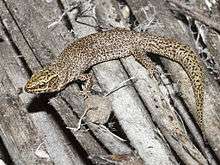Desert night lizard
| Desert night lizard | |
|---|---|
 | |
| Scientific classification | |
| Kingdom: | Animalia |
| Phylum: | Chordata |
| Class: | Reptilia |
| Order: | Squamata |
| Family: | Xantusiidae |
| Genus: | Xantusia |
| Species: | X. vigilis |
| Binomial name | |
| Xantusia vigilis Baird, 1859 | |
The desert night lizard, Xantusia vigilis, is a night lizard native to southern California east of the Sierras and San Gabriel Mountains into Baja California, southern Nevada, southwestern Utah and extreme western Arizona.
Like all night lizards, the desert night lizard is viviparous, giving birth to live young and producing 1 to 3 young from August to December. The desert night lizard attains a snout-to-vent length (SVL) of 1.5 to 2.75 in (3.8 to 7.0 cm) with a tail roughly the same length. The lizard's coloring is usually gray, yellow-brownish, or olive. Despite their name, night lizards are active during the day. They are known to easily to change their color, from light olive (usually during the evening) to dark brown during the day. It is a good climber and usually eats termites, small insects, spiders and other arthropods.
It is a secretive lizard of arid and semi-arid locales. During the day it may be found under fallen debris of desert plants and in rock crevices. It is usually associated with varieties of yucca such as the Joshua Tree, Spanish Dagger, and Spanish Bayonet.
Unusually for a lizard it forms family social groups with a father-mother pair and offspring, which may delay dispersing for years. The young are capable of feeding themselves but will huddle together with their relatives.[1] They do not receive any direct care from their parents and older siblings and it is not yet known what the advantages of staying with their parents are.[2] The baby lizards are well-camouflaged and are not much bigger than a toothpick.

The yucca night lizard, Xantusia vigilis vigilis, is a subspecies.
References
Further reading
- Baird SF. 1859. Description of New Genera and Species of North American Lizards in the Museum of the Smithsonian Institution. Proc. Acad. Nat. Sci. Philadelphia 10: 253-256. (Xantusia vigilis, new species, p. 255).
- Behler JL, King FW. 1979. The Audubon Society Field Guide to North American Reptiles and Amphibians. New York: Alfred A. Knopf. 743 pp. ISBN 0-394-50824-6. (Xantusia vigilis, pp. 551–552 + Plate 406).
- Boulenger GA. 1885. Catalogue of the Lizards in the British Museum (Natural History). Second Edition. Volume II. ... Xantusiidæ. London: Trustees of the British Museum (Natural History). (Taylor and Francis, printers). xiii + 497 pp. + Plates I-XXIV. (Xantusia vigilis, pp. 327–328).
- Goin CJ, Goin OB, Zug GR. 1978. Introduction to Herpetology, Third Edition. San Francisco: W.H. Freeman and Company. xi + 378 pp. ISBN 0-7167-0020-4. (Xantusia vigilis, pp. 129, 132, 148, 286).
- Smith HM, Brodie ED Jr. 1982. Reptiles of North America: A Guide to Field Identification. New York: Golden Press. 240 pp. ISBN 0-307-13666-3. (Xantusia vigilis, pp. 84–85).
- Stebbins RC. A Field Guide to Western Reptiles and Amphibians, Third Edition. The Peterson Field Guide Series ®. Boston and New York: Houghton Mifflin Company. xiii + 533 pp. ISBN 978-0-395-98272-3. (Xantusia vigilis, pp. 307–309 + Plate 35 + Map 76).